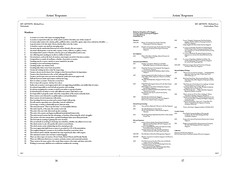Title: Manifesto
Publication: MY ARTISTS
Contributor: Michael Lee Hong Hwee
Artist: Tang Ling Nah
Publisher: WORM
Date: 2007
Along with more than 10 others, I contributed a short text, entitled "Manifesto", to artist Tang Ling Nah's bookwork MY ARTISTS, exhibited as part of the group exhibition, Whose Playground is This? (Plastique Kinetic Worms, Singapore, Jun 2007).
My text contribution comprises a list of 50 truisms on my take on the artist-curator relationship. Transcript of my text follows the page spread:

"Manifesto
1. A curator is a writer who enjoys arranging things.
2. A curator is expected to take care of the artist’s soul but who takes care of the curator’s?
3. A curator plays many roles: nanny, police, publicist, tutor, counsellor, agent, supervisor, contractor, shoulder ….
4. A good curator is for the artist whom a harsh editor is for the writer.
5. A sensitive curator can smell an emerging artist.
6. An artist may be sandwiched between two of her friends who are curators.
7. An artist’s ideal partner is an art critic, curator, writer, collector, or gallery owner.
8. An independent curator is hard to come by, just as an independent artist is rare.
9. Art collecting and curating are in direct conflict of interest.
10. Circumstances, such as the lack of curators, may inspire an artist to become a curator.
11 . Composition is a mark of excellence, whether of an artist or curator.
12 . Curating may be a career suicide or career launch for an artist.
13 . Curating is a test and training of patience.
14. Curating makes one a better artist.
15. Curating takes time away from art practice.
16. Curatorial writing involves a fair bit of guessing.
17 . Curators do not need to know how design is done but must know its importance.
18. Curators have been known to be, or feel, sabotaged by artists.
19. Curators need to get out to see more art than be enslaved to more paperwork.
20. Fallouts between artists and curators seldom last long.
21 . How to seduce a curator: Praise her recent show.
22 . How to turn off a curator: Ask her for a show.
23 . In the end, a curator’s most appreciated role is in suggesting possibilities, not unlike that of a tutor.
24. It is almost impossible to excel at both art practice and curating.
25. It is always tempting for a curator to stick to an artist or a group of artists.
26. It is beneficial for an artist to work with different curators than stick to one.
27 . It is impossible to properly curate when the composition of the artists is already fixed.
28. Most curators carry themselves as philosophers: cool and detached.
29. Most curators do not brainstorm with artists.
30. Most meetings between an artist and a curator begin with gossip.
31 . Not all curators open their eyes when they visit art exhibitions.
32 . On average, a curator is financially poorer than an artist.
33 . The announcement “This is my first time” is a formidable defence.
34. The artist may be, or become, the curator’s artwork.
35. The artist who can write often ends up also curating.
36. The artist who curates can bypass traditional institutional frameworks.
37 . The artist-turned-curator has the advantage, or burden, of knowing the artist’s struggles.
38. The curator who does not produce a printed catalogue lacks more than just funds.
39. The first task in curating is gaining the trust of artists.
40. The second task in curating is churning out a timeline, whether one adheres to it or not.
41. The ideal curator is one who pushes the artist to exceed limits.
42. The ideal curator-artist relationship involves mutual growth.
43. The most appreciated gift from a curator to an artist is a CD of documentation.
44. The toughest thing for a curator to do is tell her friend he is not in her show.
45. The trained curator and the untrained one may regard each other with suspect.
46. The untrained curator does not have certain baggage.
47. There are three types of curators: Sweet Paula, Honest Simon and Erratic Randy.
48. There are differences between co-curator, assistant curator and curatorial assistant.
49. There seems to be more artists who curate than curators who make and show artworks.
50. Writing is a necessary skill but not a sufficient condition for curating."
Use of the above texts, whether in part or full, must be properly cited:
Michael Lee, "Manifesto," MY ARTISTS (Singapore: FARM, 2007), p.36.
Related links:
WORM
Tang Ling Nah
No comments:
Post a Comment